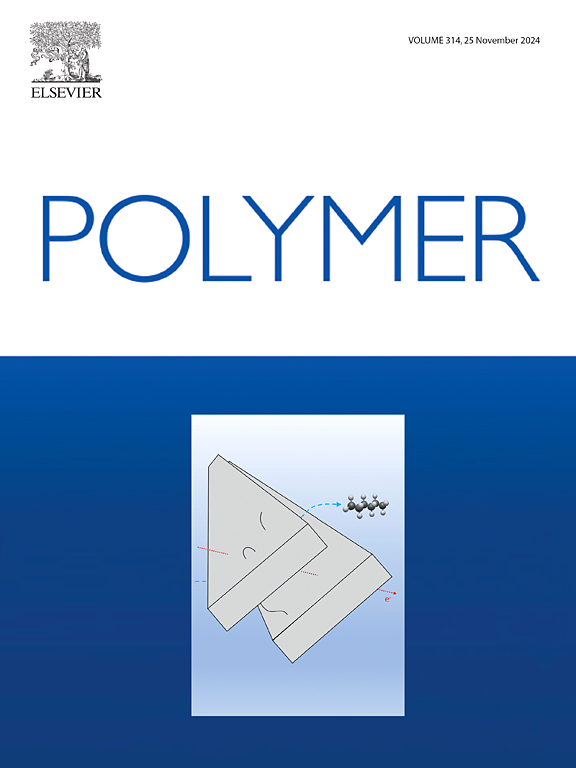密度波动和界面能在控制聚合物在阳极氧化铝中的动力学中的作用
IF 4.1
2区 化学
Q2 POLYMER SCIENCE
引用次数: 0
摘要
在本文中,我们对三种基于聚巯基丙基甲基硅氧烷(PMMS)的聚合物刷的动力学进行了介电和量热研究,这些聚合物刷接有各种丙烯酸酯单体,并渗透到以恒定孔径为特征的阳极氧化铝(AAO)多孔模板中。此外,系统的高压介质研究与接触角测量一起进行,以了解这些聚合物在纳米空间限制下的行为。特别关注的是,相对于散装样品,聚合物的“界面”和“核心”组分的和对应的位移。结果表明,这两个s(计算为)的变化在共聚物之间具有可比性。然而,为了得出更普遍的结论,我们将我们的数据与在高压和AAO膜内测量的其他类似分子量的聚合物的数据进行了比较。发现界面能()可能不足以预测两者和/或的变化。然而,玻璃化转变温度与压力系数之间存在一定的关系。这表明对密度变化更敏感的聚合物在约束下表现出更大的凹陷。尽管这些关系并不总是令人满意的。这意味着给定聚合物在约束条件下的抑制不是由单一参数控制的,而是由界面能、节段动力学的压力敏感性和聚合物的分子量之间的相互作用控制的。本文章由计算机程序翻译,如有差异,请以英文原文为准。

The Role of Density Fluctuations and Interfacial Energy in Controlling the Dynamics of the Polymers Confined within the Anodic Aluminum Oxide
In this paper, we performed dielectric and calorimetric studies on the dynamics of the three polymer brushes based on poly(mercaptopropylmethylsiloxane, PMMS), grafted with various acrylates monomers that were infiltrated into anodic aluminum oxide (AAO) porous templates characterized by the constant pore size, . Additionally, systematic high pressure dielectric investigations were done along with the contact angle measurements to understand behaviour of these polymer in the nanospatial restriction. A special focus was paid to address the shift of the and corresponding respectively to the “interfacial” and the “core” fractions, of polymers with respect to the bulk samples. Results showed that changes of both s (calculated as ) were comparable across copolymers. Nevertheless, to make more general conclusions, we compared our data with the ones collected for the other polymers of similar molecular weight measured at high pressures and within AAO membranes. It was found that the interfacial energy () might not be enough to predict the variation of both and/or . However, some relationship between the pressure coefficient of the glass transition temperature and as well as was noted. This suggests that polymers that are more sensitive to density variations show a larger depression of under confinement. Though these relationships are not always satisfied. It means that the depression of of given polymer under confinement is not governed by a single parameter, but is controlled by the interplay between the interfacial energy, pressure sensitivity of the segmental dynamics and molecular weight of the polymer.
求助全文
通过发布文献求助,成功后即可免费获取论文全文。
去求助
来源期刊

Polymer
化学-高分子科学
CiteScore
7.90
自引率
8.70%
发文量
959
审稿时长
32 days
期刊介绍:
Polymer is an interdisciplinary journal dedicated to publishing innovative and significant advances in Polymer Physics, Chemistry and Technology. We welcome submissions on polymer hybrids, nanocomposites, characterisation and self-assembly. Polymer also publishes work on the technological application of polymers in energy and optoelectronics.
The main scope is covered but not limited to the following core areas:
Polymer Materials
Nanocomposites and hybrid nanomaterials
Polymer blends, films, fibres, networks and porous materials
Physical Characterization
Characterisation, modelling and simulation* of molecular and materials properties in bulk, solution, and thin films
Polymer Engineering
Advanced multiscale processing methods
Polymer Synthesis, Modification and Self-assembly
Including designer polymer architectures, mechanisms and kinetics, and supramolecular polymerization
Technological Applications
Polymers for energy generation and storage
Polymer membranes for separation technology
Polymers for opto- and microelectronics.
 求助内容:
求助内容: 应助结果提醒方式:
应助结果提醒方式:


